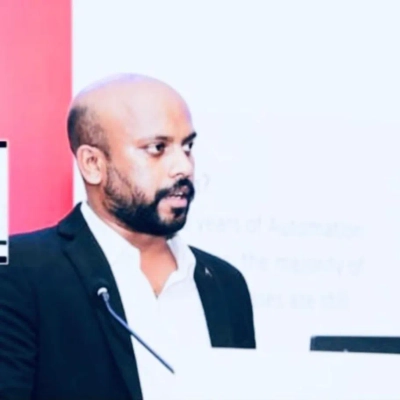We asked industry experts to share how their companies encourage employees to share their ideas and perspectives. Here are the platforms and methods they use. Discover how companies are utilizing various tools and techniques to empower their workforce and foster collaborative creativity.
- Foster a Culture of Hypothesis Testing
- Implement EOS and Strety for Idea Sharing
- Create Psychological Safety for Open Communication
- Empower Employees Through OfficeIQ and Slack
- Build Trust with Team Coaching Sessions
- Cultivate Informal Idea Sharing on Slack
- Establish Regular Check-ins for Team Input
- Host Weekly Build and Break Sessions
- Maintain an Open-Door Policy for Collaborative Innovation
- Enforce Innovation with TrackMyPrompts.com Scoreboard
- Boost Creativity with Notion and Slack
- Reward Engagement Through Ambassador Program
- Implement Feedback Huddles and Creative Syncs
- Utilize Voice of Employee Framework
- Prioritize Communication Across Global Teams
- Embed Innovation in Culture and Processes
- Combine Trust, Tools, and Recognition
- Create an Online Portal for Idea Submissions
How Companies Encourage Employees to Share Ideas: 18 Strategies
Foster a Culture of Hypothesis Testing
We treat ideas as hypotheses—they’re meant to be tested, not protected. This mindset allows everyone, from engineers to research scouts, to speak up early and often.
We’ve built a system inside Notion where anyone can submit “raw ideas” tied to specific research, market gaps, or venture experiments. These are short entries—a few lines of insight, a screenshot, or a sketch—that reside in our “idea greenhouse.” Every two weeks, we conduct asynchronous review rounds, upvote the most promising ideas, and assign mini task forces to investigate further.
But what’s the real breakthrough?
We’ve made it safe to be wrong. That’s the method. We don’t punish bad ideas—we reward the signal behind them. This is how we’ve built a culture where ideas don’t need permission to exist.
 Igor Trunov
Igor Trunov
CEO, Atlantix
Implement EOS and Strety for Idea Sharing
At our company, fostering open communication and empowering employees to share their ideas is a core value. We believe the best solutions emerge when everyone’s voice is heard, and we use structured methods to ensure that happens consistently.
We implement the Entrepreneurial Operating System (EOS), which provides a clear, practical framework for regular team communication and idea sharing. One of the key elements is the Level 10 Meeting™, a weekly structured meeting where every team member is encouraged to raise issues, suggest improvements, and offer feedback. The Issues List, a standard part of each meeting, is an open forum—no idea is too small or too bold. This ensures that innovative solutions and challenges are surfaced and discussed collaboratively.
To further support ongoing dialogue, we leverage Strety as our digital platform. Strety enables employees to share updates, recognize peers, and track progress on goals in real time. Its interactive features create a transparent space for feedback, allowing ideas to be documented, revisited, and integrated into the company strategy. Employees can submit suggestions asynchronously, which is especially valuable for remote and hybrid teams.
Beyond tools and meetings, we place high value on psychological safety. Leaders model open-mindedness, actively solicit input, and recognize contributions publicly—whether during meetings or through Strety. We celebrate not just successful ideas, but also the willingness to speak up and challenge the status quo.
By combining the structured discipline of EOS with the flexibility and transparency of Strety, we create multiple, accessible channels for idea sharing. This approach helps us tap into the creativity and experience of our entire team, ensuring we remain agile, innovative, and aligned as we grow.
 Adrian Ghira
Adrian Ghira
Managing Partner & CEO, GAM Tech
Create Psychological Safety for Open Communication
Creating a space where people genuinely feel comfortable sharing ideas is something we prioritize deeply. For us, it’s not about forcing innovation; it’s about ensuring that people know their voice matters, regardless of their title or background.
Before anything else, it starts with psychological safety. We try to foster a culture where it’s okay to challenge ideas, propose unconventional solutions, or even fail in the pursuit of something new. This means:
- Actively celebrating small experiments, even if they don’t work.
- Showing appreciation when someone questions the status quo.
- Ensuring leadership leads by example by asking for feedback and demonstrating vulnerability.
We have a dedicated page in Notion called the Idea Vault where team members can submit thoughts at any time, including features, process improvements, user pain points, or even wild ideas that don’t quite “fit” yet. It’s open to everyone, and we review it weekly.
For more spontaneous input, we use Slack. Quick thoughts, voice notes, even sketches—everything goes. It maintains an informal flow and encourages real-time sharing.
Once a month, we have a call with no set agenda except: “What’s on your mind?” People can present an idea, a frustration, or just something they noticed. We’ve had great features and fixes emerge from these.
Especially useful for remote teams, Miro helps visual thinkers get involved. We often use it during team sprints to map out user journeys, growth loops, or product features, and anyone can contribute before, during, or after.
Sometimes, the best ideas come from those who are unsure how they’ll be received. To reduce that friction, we allow anonymous idea sharing through a Typeform form embedded in Notion.
- Give credit openly. When someone’s idea is implemented, we make a point to acknowledge them publicly.
- Don’t overprocess creativity. Sometimes, over-structuring idea sharing makes it feel bureaucratic. Keep it lightweight and organic.
- Document ideas, even if the timing’s not right. Not every idea is actionable now, but having a “backlog of brilliance” is incredibly useful.
- Make space, not pressure. People are more likely to share ideas when they’re not being forced to “be innovative.” Create the space and freedom to think.
Ultimately, it’s not just about using the right tools; it’s about creating the kind of environment where people want to share. That’s what makes the difference.
 Livia Oboroceanu
Livia Oboroceanu
CEO, Founder, Acadova
Empower Employees Through OfficeIQ and Slack
At our company, we not only encourage idea-sharing, but we also expect it. Everyone, regardless of title, is empowered to speak up, challenge assumptions, and propose better ways of doing things. We’ve built this into our culture with open channels on Slack for brainstorming, regular asynchronous idea boards, and monthly “what’s not working” sessions where honest feedback is welcomed without filters. We also utilize our own AI platform, OfficeIQ, to capture and organize ideas from across the company, ensuring that nothing gets lost and the best ones rise to the top. The goal is simple: make it easier for smart people to think out loud and be heard, because that’s how real progress happens.
 Krishna Bhatt
Krishna Bhatt
Founder and CEO, Webuters Technologies
Build Trust with Team Coaching Sessions
Encouraging employees to share ideas requires cultivating trust and open communication. Build trust by actively listening, asking thoughtful questions about each person’s individual goals and strengths, and showing genuine interest in their unique experiences. One effective method is bringing in a team coach to facilitate sessions on topics such as psychological safety. Having both team members and leaders participate equally helps break down hierarchies and encourages open dialogue. This external, neutral facilitation creates a space for honest input, making employees feel heard and valued, which ultimately leads to increased collaboration, creativity, and engagement across the team.
 Emma Gray
Emma Gray
Founder, Empathrive
Cultivate Informal Idea Sharing on Slack
Slack is our go-to platform for everything, so we keep it simple. We have channels for work-related matters, of course, but also ones for sharing random ideas, cool links, or things we’ve seen other companies do that might spark inspiration. No idea is too small or “off-beat” to share; I’ve literally dropped half-baked thoughts mid-coffee break, and the team has jumped on them and turned them into something tangible.
We’ve built a culture where everyone feels safe sharing ideas, even if they’re a little unconventional or rough around the edges. We also conduct weekly check-ins where we ask, “What’s something new you’re thinking about?” It’s not a formal setting, just a space to chat. Some of our best growth ideas have come from these casual Slack conversations.
It simply works when people feel like their voice matters.
 Kristiyan Yankov
Kristiyan Yankov
Growth Marketer, Co-Founder, AboveApex
Establish Regular Check-ins for Team Input
We’re a small, focused team working closely on technical drafting projects for architects, contractors, and engineers. In this environment, every voice carries weight, and I take full responsibility for ensuring those voices are heard.
One thing I’ve learned is that people won’t speak up just because you tell them they can. You need to create rhythms that invite input. That’s why we hold regular check-ins, where we don’t just discuss current projects but also explore areas for improvement.
I open those meetings by asking questions like, “What’s getting in your way this week?” or, “Has anyone found a faster or cleaner way to do X?”
Outside of meetings, we use a shared Slack channel where team members can drop suggestions at any time. Some are big, like shifting how we structure site plans. Others are minor tweaks to how we flag markups or organize file names. Regardless of size, if someone suggests something that makes sense, I try it. And if it works, I will implement it quickly and give them credit.
Ultimately, I own the culture. So if someone doesn’t feel safe or encouraged to speak up, that’s on me to fix. When people see their ideas taken seriously and put into practice, it builds confidence, collaboration, and a stronger final product. That’s how we get better, not just as a company, but as a team.
 Brian Curran
Brian Curran
Founder, Drafting Services
Host Weekly Build and Break Sessions
I believe that ideas don’t flow simply because a company claims to listen. You need to create visible and repeatable systems that demonstrate this commitment.
We host “Build and Break Thursdays.” This is a 45-minute weekly session where anyone can present an issue, suggest a new feature, or showcase a working prototype. Everyone uses Notion to log ideas and Slack threads to provide real-time input.
One of our most successful platform features, the natural language test step generator, originated from an intern during one of these sessions. That input now influences how hundreds of teams use our platform for writing test cases.
The lesson is simple: When people know their ideas are documented, reviewed, and acted upon, they continue to contribute. This is how real innovation builds from within.
 Vivek Nair
Vivek Nair
Co-Founder, BotGauge
Maintain an Open-Door Policy for Collaborative Innovation
Good ideas can come from every corner of the room. Our team is built on trust, respect, and a shared drive to do right by our clients. This means everyone’s voice matters, whether you’re a senior attorney or a new team member just finding your footing.
We keep things open and real. We don’t believe in stiff, formal suggestion boxes or bureaucratic layers that shut people down. We have an open-door policy that’s more than just a phrase. Transparency and authenticity are part of our core values. Whether we use team huddles, regularly scheduled one-on-ones, or quick Teams messages, we make it easy for people to speak up, share ideas, or flag something that’s not working.
Ultimately, our firm operates on collaboration, not hierarchy. We hire people who care deeply and think boldly, and we give them the space and respect to do both. Because when our team thrives, our clients win. And that’s the goal every single time.
 Yosi Yahoudai
Yosi Yahoudai
Co-Founder & Managing Partner, J&Y Law
Enforce Innovation with TrackMyPrompts.com Scoreboard
We use TrackMyPrompts.com—not just as a productivity tool, but as a cultural enforcement mechanism. Every team member is required to log at least one original idea, insight, or strategic prompt per week. The platform timestamps it, tracks iterations, and assigns votes for feasibility and impact. This is not a Slack thread buried in emojis—it’s a live innovation scoreboard. Everyone sees who’s thinking ahead and who’s asleep at the wheel. This system forces sharp thinking from even the quietest analyst and surfaces genius from places traditional leadership would overlook.
 Andrew Juma
Andrew Juma
Founder and CEO, The AJ Center
Boost Creativity with Notion and Slack
Encouraging employees to share their ideas is like cultivating a thriving garden; nurture it, and it will flourish. We harness Notion for organized brainstorming sessions and Slack for spontaneous idea exchanges, creating a dynamic environment where creativity can thrive.
Since integrating these platforms, we’ve experienced a 35+% increase in actionable project proposals, demonstrating that when team members feel empowered to voice their insights, innovation flourishes. For instance, a recent idea led to a new content strategy for our client, which boosted organic traffic by approximately 25% within just two months.
To maintain this momentum, we hold regular “Idea Jam” huddles via Slack, where everyone can share their thoughts, ensuring that every voice is heard and valued. This approach not only enhances our projects but also strengthens our team culture, making us more agile and responsive to client needs.
 Marko Rojnica
Marko Rojnica
Founder & CEO, Ventnor Web Agency
Reward Engagement Through Ambassador Program
Motivating employees to participate actively in corporate life can be quite challenging. It is challenging for us as an outstaffing company. However, creativity is our edge—it’s how we find solutions that make a real difference.
We’ve always known that recognition motivates people. That’s why we were seeking ways to integrate it into the employee journey systematically. We launched a special Ambassador Program that rewards all expert efforts with internal currency (stars). From taking part in activities to suggesting new events, incentives, or projects, all actions are rewarded according to the policy. Experts can exchange internal currency for exclusive swag in our internal shop.
As a result, we see a dramatic increase in expert engagement in corporate life, along with dozens of innovative ideas. What is also important is to give feedback on every idea, even if it is not suitable for the company at present. This shows that every voice matters—and offers great ideas the space to grow.
 Yuliia Shohan
Yuliia Shohan
Brand Lead, ALLSTARSIT
Implement Feedback Huddles and Creative Syncs
Encouraging ideas is more than a policy at our company. It is something we live by every day. We employ various methods to ensure that everyone can share their thoughts openly.
Every quarter, we hold Feedback Huddles. These are honest one-on-one video chats with leadership. There’s no agenda, just two questions: “What’s fueling your work?” and “What’s blocking your flow?” We listen deeply and act quickly on what we hear. This builds genuine trust.
Once a month, we have Creative Syncs. These are informal company-wide meetups. It’s a safe space for fresh ideas and collaboration. We utilize digital whiteboards and anonymous idea submissions to engage everyone, including quieter voices.
Every day in our Scrums, we openly discuss current problems. Everyone shares their views and ideas to find solutions together. This collaborative approach ensures all voices are heard and challenges are addressed quickly.
We also occasionally run quick anonymous Pulse Checks through chatbots. These polls ask insightful questions like, “What should we stop doing?” and, “Who inspired you today?” The answers immediately shape our priorities.
 Nishita Arora
Nishita Arora
Content Team Lead, WrittenlyHub
Utilize Voice of Employee Framework
We know that some of the best innovations and process improvements come from within our teams. To create a culture where ideas and diverse perspectives are not only welcome but actively sought out, we’ve built structured, scalable ways for employees to contribute.
At the heart of this is our Voice of the Employee framework, which combines real-time collaboration tools and formal feedback channels. We use Slack for cross-functional ideation and more structured tools, such as Lattice, for engagement surveys and performance reviews. These are baked into our operating rhythm, so feedback is consistently collected, reviewed, and acted upon.
Beyond digital channels, we host quarterly innovation roundtables and executive listening sessions, where employees can present their ideas directly to leadership. These are designed to surface insights but also to create psychological safety and demonstrate that feedback isn’t just welcome; it’s operationally impactful.
Most importantly, we close the feedback loop. When employees see their input reflected in product changes, policy changes, or internal process improvements, it reinforces a culture of shared ownership and continuous improvement.
By fostering open dialogue and providing clear paths for ideas to influence real decisions, we’ve created a workplace where employees feel heard and empowered through engagement, alignment, and innovation at scale.
 Yaniv Masjedi
Yaniv Masjedi
Chief Marketing Officer, Nextiva
Prioritize Communication Across Global Teams
Maintaining constant communication across teams is a core part of our daily operations. Our employees are spread across multiple countries and time zones, so we prioritize frequent touchpoints to ensure everyone stays connected and empowered to share their ideas.
We hold daily or weekly meetings, depending on each team’s needs, allowing for open discussions, updates, and providing a space for employees to bring forward suggestions directly. Beyond regular team meetings, direct access to managers and cross-department peers ensures that ideas can be shared informally at any time, without unnecessary barriers.
For task management and project visibility, we use Trello to organize assignments, track progress, and collaborate efficiently across departments and locations. Additionally, tools like Microsoft Teams support instant communication, while leadership maintains an open-door policy supported by recurring town halls and feedback sessions.
This combination of structured meetings, open access to leadership, and collaborative digital tools allows us to gather valuable input from all employees and continuously improve both internal processes and the global services we provide to our clients.
 Ion Oyarzun
Ion Oyarzun
Marketing Specialist, INS Global
Embed Innovation in Culture and Processes
We actively create space for employees to share ideas by embedding it into both our culture and processes. One of the most effective methods we use is regular innovation-focused sessions, where cross-functional teams can pitch solutions, propose product features, or flag improvement opportunities. These sessions are not limited to management—any team member can contribute.
We also utilize structured tools, such as Confluence, to collect feedback asynchronously, as well as Slack channels dedicated to knowledge sharing and suggestions. For more strategic initiatives, we host internal R&D challenges that encourage experimentation and team-led innovation, often leading to real client-facing features or internal tools.
The key is making it clear that contributions are valued and will be acted upon—our team sees their ideas move from discussion to implementation, which keeps engagement high.
 Sergiy Fitsak
Sergiy Fitsak
Managing Director, Fintech Expert, Softjourn
Combine Trust, Tools, and Recognition
We create an environment of trust and psychological safety, which empowers employees to share their ideas freely. We employ both structured and informal methods, including cross-functional innovation councils and dedicated spaces on digital platforms such as Microsoft Teams. Anonymous feedback tools are also implemented to capture input from all individuals, regardless of their role or tenure. Recognition is key—we celebrate ideas that add value to reinforce the belief that innovation is a shared responsibility. This combination of trust, tools, and recognition drives engagement and integrates innovative thinking into our daily culture.
 Rommel Regino
Rommel Regino
Evp and Chief Operating Officer | Driving Growth, Enhancing Customer and Employee Experience, INSPIRO
Create Online Portal for Idea Submissions
We have established a dedicated online portal where our team members can submit ideas and recommendations for enhancing our products, processes, or overall corporate operations. Team members may exchange their creative ideas and suggestions on this central hub.
Employees can access the portal and submit thorough ideas, along with any supporting documentation or prototypes, thereby simplifying the process. Our dedicated innovation team then reviews these ideas to assess their viability, potential impact, and alignment with our strategic business goals.
Every idea presented by the innovation team is carefully evaluated in terms of elements such as potential efficiency improvements, customer experience enhancements, or income-generating potential. The most exciting concepts are then selected for further development and application.
We empower our staff members to actively contribute to our growth and evolution by providing this dedicated idea submission platform. This not only leverages the diverse perspectives and knowledge within our team but also fosters innovation and ongoing development. Utilizing the best ideas that have emerged through this portal has significantly helped us maintain our position as the top news source for resellers and advance our company.
 Ryan McDonald
Ryan McDonald
COO, Resell Calendar







